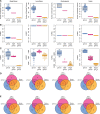Stable Iterative Variable Selection
- PMID: 34270690
- PMCID: PMC8665768
- DOI: 10.1093/bioinformatics/btab501
Stable Iterative Variable Selection
Abstract
Motivation: The emergence of datasets with tens of thousands of features, such as high-throughput omics biomedical data, highlights the importance of reducing the feature space into a distilled subset that can truly capture the signal for research and industry by aiding in finding more effective biomarkers for the question in hand. A good feature set also facilitates building robust predictive models with improved interpretability and convergence of the applied method due to the smaller feature space.
Results: Here, we present a robust feature selection method named Stable Iterative Variable Selection (SIVS) and assess its performance over both omics and clinical data types. As a performance assessment metric, we compared the number and goodness of the selected feature using SIVS to those selected by Least Absolute Shrinkage and Selection Operator regression. The results suggested that the feature space selected by SIVS was, on average, 41% smaller, without having a negative effect on the model performance. A similar result was observed for comparison with Boruta and caret RFE.
Availability and implementation: The method is implemented as an R package under GNU General Public License v3.0 and is accessible via Comprehensive R Archive Network (CRAN) via https://cran.r-project.org/package=sivs.
Supplementary information: Supplementary data are available at Bioinformatics online.
© The Author(s) 2021. Published by Oxford University Press.
Figures



References
-
- Apolloni J. et al. (2016) Two hybrid wrapper-filter feature selection algorithms applied to high-dimensional microarray experiments. Appl. Soft Comput., 38, 922–932.
-
- Bioinformatics Pipeline: mRNA Analysis-GDC Docs, mRNA Analysis Pipeline, https://docs.gdc.cancer.gov/Data/Bioinformatics_Pipelines/Expression_mRN... (17 May 2021, date last accessed).
-
- Bonnet A., Levy-Leduc C. (2015) EstHer: estimation of heritability in high dimensional sparse linear mixed models using variable selection, version 1.0, https://CRAN.R-project.org/package=EstHer.
-
- Buse J.B. (2007) Action to Control Cardiovascular Risk in Diabetes (ACCORD) Trial: design and methods. Am. J. Cardiol., 99, S21–S33. - PubMed

